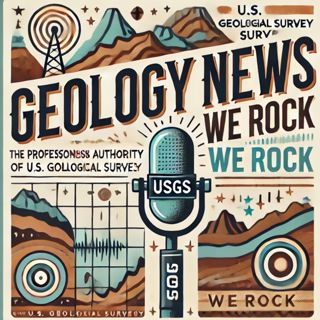
"Yellowstone Calm, Kilauea Paused, and Critical Minerals Explored: Latest U.S. Geological Developments"
In the past week, the United States has seen several notable developments in geology that reflect both regional and global trends. At Yellowstone National Park, the U.S. Geological Survey reports that caldera activity remains at background levels with no indication of increased volcanic threat. June saw around 60 small earthquakes in the region, the largest reaching magnitude 2.7, and deformation measurements indicate the usual summertime pause in long-term subsidence. A notable event was a minor eruption at Black Diamond Pool in Biscuit Basin, captured by the new webcam system in mid-June. Steamboat Geyser also continues to have minor eruptions, with two major eruptions having occurred so far this year, prompting geologists to monitor for potentially larger outbreaks in the coming weeks.On the volcanic front in Hawaii, the Kilauea Volcano’s Halemaʻumaʻu eruption is currently paused following the end of episode 29 on July twentieth, after more than 13 hours of lava fountaining. According to the Hawaiian Volcano Observatory, inflation at the summit is ongoing with persistent low-level tremor and gas emissions. Indicators suggest that renewed eruptive activity could begin within days. All eyes remain on Kilauea, given its dynamic and frequently changing activity, though currently no significant changes are occurring at the East Rift or Southwest Rift Zones.Turning to resource geology, the Florida Geological Survey’s recent July update describes ongoing research and monitoring of the state’s surficial geologic formations in the western Panhandle, particularly the mineable deposits of quartz sand and clay known as the Citronelle Formation. Attention has also turned to the Trail Ridge sands of northeast Florida, which are primarily mined for titanium but are now being assessed for their potential as a source of rare earth elements. This reflects a growing national focus on critical minerals needed for technology and defense, and reinforces the importance of geologic mapping and resource assessment.Nationally, the U.S. Geological Survey has released a new assessment of undiscovered oil and gas resources in the Niobrara Formation, underlying parts of southwest Wyoming and northwest Colorado. Estimates now stand at around 703 million barrels of oil and 5.8 trillion cubic feet of natural gas, information that could shape regional energy development strategies in the coming years.Internationally, seismic activity has made headlines with the magnitude 8.8 earthquake off the Kamchatka Peninsula in Russia on July twenty ninth. The United States Geological Survey confirms this event as the largest global earthquake since the 2011 Tohoku event in Japan, generating a series of aftershocks that have drawn attention to subduction zone hazards around the world. These recent geological events and findings highlight the importance of continuous monitoring and research, especially as evolving patterns in resource use and seismic risks demand ongoing attention and preparedness.Some great Deals https://amzn.to/49SJ3QsFor more check out http://www.quietplease.aiThis content was created in partnership and with the help of Artificial Intelligence AI
30 Juli 3min

Mount Rainier Earthquake Swarm and Yellowstone Volcanic Activity Capture Scientific Attention Amid Geologic Updates Across the US
In the United States this July, Mount Rainier in Washington has captured scientific attention as a significant swarm of small earthquakes began on July 8 according to the US Geological Survey's Cascades Volcano Observatory. This event is described as the largest recorded earthquake swarm ever at the volcano. Experts are closely monitoring the activity, as persistent earthquake sequences sometimes indicate changes in fluid movement or magmatic processes within the volcano and could signal evolving hazards. While no immediate threat has been identified, ongoing seismicity remains a focal point for researchers given Mount Rainier's proximity to major population centers.Meanwhile, activity at Yellowstone continues to be actively tracked. The US Geological Survey’s July 1 monthly update states current alert levels for the Yellowstone caldera remain normal. In June, Yellowstone experienced about sixty small earthquakes, the largest reaching magnitude two point seven. The annual summer pause in caldera subsidence was noted, and minor hydrothermal eruptions have occurred at features like Black Diamond Pool in Biscuit Basin, with a second eruption recently captured on the park’s new digital camera system. Steamboat Geyser remains restless, with minor eruptions suggesting a major eruption could be imminent. These findings underscore the value of real-time monitoring in a region of such geologic significance.In the Southeast, the Florida Geological Survey’s July research spotlighted the geology and economic value of heavy mineral sands in northeastern Florida’s Trail Ridge. These sands, mined for titanium, are also under assessment as a potential source of rare earth elements, which are important for high-tech industries and national security. This research, as highlighted by the Florida Geological Survey, helps policymakers and the public understand the geologic resources that underpin local and national economies.Turning to the Rocky Mountain West, the US Geological Survey announced a new assessment estimating the Niobrara Formation in southwestern Wyoming and northwestern Colorado contains over seven hundred million barrels of oil and nearly six trillion cubic feet of natural gas. This finding reflects the ongoing importance of geologic research for energy resource management in the United States and adds fresh data for the industry and policymakers.Internationally, attention remains on Klyuchevskoy volcano in Russia’s Kamchatka Peninsula, which continues to show notable thermal anomalies. The Smithsonian Institution’s Global Volcanism Program reported the volcano remains at an elevated aviation color code, reflecting persistent activity observed in satellite imagery.Altogether, recent geologic news highlights a period of heightened monitoring at several US volcanoes, ongoing research into economically significant minerals, and significant updates on domestic energy resources. The pattern across this month underscores the critical role that geoscientific research and monitoring play in understanding hazards, managing resources, and informing the public on geological events in both the United States and worldwide.Some great Deals https://amzn.to/49SJ3QsFor more check out http://www.quietplease.aiThis content was created in partnership and with the help of Artificial Intelligence AI
26 Juli 3min

Niobrara Formation's Massive Oil and Gas Potential Unveiled by USGS
The U S Geological Survey recently released a new assessment estimating that the Niobrara Formation in southwestern Wyoming and northwestern Colorado contains seven hundred three million barrels of oil and five point eight trillion cubic feet of natural gas. This formation is part of the Mowry Composite Total Petroleum System, an ancient shallow ocean bed that once covered parts of the Rocky Mountain region. Such assessments are critical for understanding the domestic energy potential and informing resource management decisions in the United States, according to the U S Geological Survey.Meanwhile, the July edition of the Florida Geological Survey’s newsletter details ongoing research into Florida’s unique geologic history and economic resources. In the western Florida Panhandle, mineable quartz sand and clay continue to be significant, originating from sediment deposited as the Citronelle Formation. The Trail Ridge sands in northeast Florida are being explored not only for their titanium content but increasingly as a potential domestic source for rare earth elements, which are vital for technology and defense. State geologists highlighted upcoming geological mapping projects and noted the upcoming designation of Florida’s ninth State Geological Site, reflecting a growing public interest in geological education and conservation, according to the Florida Geological Survey.Across the country, the U S Geological Survey is conducting low-level flights to image the geology over areas such as the Black Hills and Bear Lodge region, aiming to improve mapping accuracy and support land management in the western United States. They have also advanced remote sensing efforts with the release of the latest National Land Cover Database data, now providing a forty year record of land cover change across the contiguous United States. This dataset is instrumental for tracking landscape transformation, urban development, and environmental changes, as reported by the U S Geological Survey.Geological events and outreach continue to engage the public, with the Bryce Canyon National Park hosting its annual Geology Festival on July eighteenth and nineteenth. This event offers educational programs and guided geology walks, underscoring how geology remains foundational to public land interpretation and park experiences, as described by the National Park Service.Globally, seismic activity remains above average for early July. Planetary and lunar alignments have coincided with increased earthquake potential according to independent seismic observers, with worldwide records showing several earthquakes above magnitude five, as reported by Volcanodiscovery and recent seismic updates.On the research and events front, major international conferences, such as ECOFRI on melt inclusions in Turin and the volcanic resource IAVCEI meeting in Geneva, have highlighted advances in understanding magma, volcanism, and mineral wealth, reinforcing the global collaboration essential to geology. These ongoing discoveries and data releases exemplify the evolving nature of geology, both as a practical resource science in the United States and as a driver of international research and public engagement.Some great Deals https://amzn.to/49SJ3QsFor more check out http://www.quietplease.aiThis content was created in partnership and with the help of Artificial Intelligence AI
23 Juli 3min

Great Sitkin Volcano Erupts in Alaska, Yellowstone Remains Stable: USGS Updates and Upcoming Geological Events
Lava continues to erupt from the summit crater of Great Sitkin Volcano in Alaska, with elevated surface temperatures observed through satellite imagery throughout the week as reported by the United States Geological Survey. This site has seen persistent volcanic activity, but no imminent threat to nearby communities has been identified. In contrast, Yellowstone Caldera in Wyoming remains at normal background levels. The most recent update for July notes 60 detected earthquakes in June, the largest registering magnitude two point seven, and a webcam documented a minor eruption of Black Diamond Pool. Summer deformation data continues to indicate the expected seasonal pause in caldera subsidence, and overall volcanic risk in Yellowstone remains low according to the USGS.Meanwhile, celebration and outreach remain essential parts of the geological calendar. Bryce Canyon National Park in Utah is hosting the annual Geology Festival, known locally as Geo Fest, on July eighteenth and nineteenth. The event highlights the spectacular rock formations of the park and features hands-on educational experiences designed to foster public appreciation for Earth’s dynamic processes, as outlined by the National Park Service.Mapping efforts have yielded valuable data on Earth’s surface and resources. The United States Geological Survey released the latest addition to the National Land Cover Database, marking forty years of comprehensive, raster-based land use analysis. The newly updated dataset provides annual records of land cover types, change, and impervious surface metrics across the lower forty-eight states. This collection offers researchers and policymakers deeper insight into ongoing landscape changes driven by natural forces and human development.On the energy sustainability front, a historic milestone was recently achieved with the creation and public release of the first-ever national map detailing the potential for geologic hydrogen within the contiguous United States. According to the US Geological Survey, this groundbreaking map outlines regions with geologic conditions favorable for natural hydrogen deposits, particularly across Kansas, Iowa, Minnesota, Michigan, the Four Corners states, stretches of the California coast, and the Eastern seaboard. Long considered an improbable resource, geologic hydrogen now emerges as a promising clean energy candidate. Preliminary estimates suggest the United States may contain vast reserves, with an energy content potentially double that of the world’s proven natural gas reserves.Internationally, key geoscience conventions are taking place, including the upcoming Fourth International Congress on Earth and Geological Sciences in Paris and workshops on heritage stone in Dublin. These events, as promoted by organizations such as the International Union of Geological Sciences, illustrate global momentum in advancing geological research and collaboration.Across the United States, from active volcanoes in Alaska to national land cover assessments and groundbreaking hydrogen resource mapping, geology continues to offer new insights into both hazards and sustainable opportunities while connecting communities through science and education.Some great Deals https://amzn.to/49SJ3QsFor more check out http://www.quietplease.aiThis content was created in partnership and with the help of Artificial Intelligence AI
19 Juli 3min

Unearthing America's Geological Wonders: Hydrogen Exploration, Seismic Shifts, and Volcanic Spectacles
A wave of impactful geology news has shaped the past week across the United States, highlighting both scientific discovery and ongoing natural hazards. The US Geological Survey made headlines by releasing the first-ever map showing the potential for naturally occurring geologic hydrogen across the contiguous United States. This map identifies several prime regions that may contain significant underground hydrogen resources, such as a large area in the mid-continent stretching through Kansas, Iowa, Minnesota, and Michigan, as well as strong potential along the California coast, in the Four Corners region encompassing Arizona, Colorado, New Mexico, and Utah, and along the eastern seaboard. For many years, experts believed naturally occurring hydrogen did not accumulate in sufficient quantities for energy use, but this new map challenges that assumption and opens exploring new directions in energy resource development. According to the US Geological Survey, if even a fraction of the estimated recoverable hydrogen is confirmed, the energy content could rival or exceed that of global proven natural gas reserves.Earthquake activity remains a focal point, especially in Alaska, where the largest tremor recorded in the past twenty-four hours reached magnitude 5.4 roughly thirty-six miles east of Atka, in the Aleutians West Census Area. Although considered moderate in size, an earthquake of this magnitude is a reminder of the seismic risks faced by communities along the seismically active Aleutian chain.Hawaii’s Kilauea volcano also remains in the geological spotlight. According to the Hawaiian Volcano Observatory, the recent episode of eruptions at Halemaʻumaʻu crater concluded on July 9. Summit inflation picked up immediately after, accompanied by persistent low-level degassing and seismic tremor. Volcanologists indicate that these signs point to another eruptive phase likely to begin sometime between July 16 and 19. Hazards in the area continue to include volcanic gas emissions and windblown volcanic glass, emphasizing the need for ongoing monitoring and public awareness.Beyond immediate hazards and potential resources, long-term geologic processes are being re-examined. A recent NASA study reported by Smithsonian Magazine shows that regions across California, including major cities like Los Angeles, San Francisco, and the Central Valley, are experiencing substantial ground subsidence due to groundwater extraction, landslides, and sediment compaction. This land sinking, or subsidence, will likely worsen the effects of sea-level rise in already vulnerable coastal areas.Public engagement with geology continues through events like the upcoming Bryce Canyon Geology Festival, scheduled for July 18 and 19 in Utah, where visitors can interact with scientists and learn directly about the forces shaping the landscape. From frontier hydrogen exploration to the ongoing dance of volcanic and seismic activity and the subtle yet profound shifts of landscapes, the science of geology is revealing a dynamic and ever-changing American terrain.Some great Deals https://amzn.to/49SJ3QsFor more check out http://www.quietplease.aiThis content was created in partnership and with the help of Artificial Intelligence AI
16 Juli 3min

"Seismic Shifts and Geologic Discoveries: A Dynamic Landscape Across the United States"
Recent geology news across the United States reveals a landscape both dynamic and educational, underscored by fresh seismic activity, public events, and new scientific assessments. In the Pacific Northwest, monitoring stations detected a notable earthquake swarm beneath Mount Rainier in Washington beginning on July eighth. According to the United States Geological Survey, these were small-magnitude quakes, but their clustered occurrence has drawn attention to the ongoing seismic processes beneath one of the country’s most iconic volcanoes. Although current risk remains low, the activity serves as a reminder of the region’s geologic volatility and the importance of continued monitoring.Further south, Yellowstone remains under careful observation. The Yellowstone Volcano Observatory reported that caldera activity is at normal background levels. In June, sixty minor earthquakes were located in the region, with the largest registering a magnitude of two point seven. Ground deformation data suggest the annual seasonal pause in caldera subsidence began last month. Notably, there was another small hydrothermal eruption at Black Diamond Pool in Biscuit Basin in mid-June, captured by a recently installed webcam. Such eruptions, while minor, provide valuable insight into the complex hydrothermal dynamics of this supervolcano. Steamboat Geyser continues its erratic activity, with two major eruptions already recorded in this calendar year, raising interest about a possible larger event in the coming weeks.Elsewhere in the United States, geologic events are sparking curiosity and community engagement. In the Ozarks of Arkansas, recent exploration events have combined science education with hands-on experiences. A July hike at Bear Hollow Creek led participants through fossil hunting and interactive lessons on how ancient seas shaped today’s landscapes. These outreach activities are nurturing a new appreciation for the region’s geologic past and connecting people of all ages with the tangible evidence of plate tectonics and mineral cycles.Meanwhile, scientists from the United States Geological Survey have released a new assessment of the Mowry Composite Total Petroleum System, spanning southwestern Wyoming, northwestern Colorado, and parts of Utah. This assessment focuses on sedimentary deposits from a prehistoric ocean, advancing our understanding of the area’s fossil fuel potential and its geologic history.Looking globally, major geological conferences in Europe, such as the International Congress on Earth and Geological Sciences in Paris later this month and recent volcanic research meetings in Switzerland, are fostering international collaboration and knowledge sharing. These events reflect the broader trend of integrating new technology and cross-disciplinary data to interpret our planet’s past and prepare for future hazards. Overall, recent geology news in the United States highlights a blend of scientific vigilance, educational outreach, and global cooperation that drives both public understanding and ongoing research.Some great Deals https://amzn.to/49SJ3QsFor more check out http://www.quietplease.aiThis content was created in partnership and with the help of Artificial Intelligence AI
9 Juli 3min

Volcanic Insights and Geologic Engagement Across the United States
Over the past week, geology in the United States has been marked by both scientific observation and public engagement. In Yellowstone National Park, the United States Geological Survey reported that volcanic and hydrothermal activity remains within normal levels. June saw sixty minor earthquakes, the largest registering magnitude two point seven, and ongoing monitoring of land subsidence in the caldera. The agency highlighted small eruptions from the Black Diamond Pool in Biscuit Basin, with their recently installed webcam capturing a second event in June. Steamboat Geyser continues to show minor eruptions and is being closely watched for a potential larger eruption, with two major events already recorded this year, signaling sustained hydrothermal activity in the area according to the US Geological Survey.Meanwhile, in Hawaii, geological activity has kept scientists on alert. The Hawaiian Volcano Observatory confirmed ongoing updates and close observation of Kilauea, one of the world’s most active volcanoes. Recently, Kilauea experienced another episode of lava fountaining at the summit, continuing a year-long period with frequent short-lived eruptions. The National Park Service also announced July helicopter operations over Mauna Loa and the Kahuku Unit, in part to support geological surveys, native species monitoring, and control of invasive plants. These activities are vital for understanding the evolving landscape and maintaining ecological balance in Hawaii Volcanoes National Park.Across the continental United States, public interest in geology is also on the rise. The Ozark region hosted a hands-on geology event in Bear Hollow Creek, Arkansas, where participants searched for fossils and learned about regional geological history. This educational focus connects people directly with the land’s ancient origins and highlights the importance of local geology in understanding Earth’s broader history.Looking to the southwest, Bryce Canyon National Park is preparing for its annual Geology Festival, set for July eighteenth and nineteenth. The event traditionally offers educational programs, guided walks, and opportunities for visitors to interact with professional geologists, reinforcing the region’s commitment to geoscience education and awareness.Internationally, geologists are convening for global conferences such as the recent European Current Research on Fluid and Melt Inclusions in Italy and the upcoming International Congress on Earth and Geological Sciences in Paris. These gatherings underscore an ongoing global effort to share the latest findings and methods, advancing the science of geology worldwide.From volcanic observations in the nation’s iconic parks to public outreach and international collaboration, the latest geology news reflects a dynamic field where scientific vigilance and community participation go hand in hand, helping society better understand and adapt to the ever-changing Earth.Some great Deals https://amzn.to/49SJ3QsFor more check out http://www.quietplease.aiThis content was created in partnership and with the help of Artificial Intelligence AI
7 Juli 2min





















